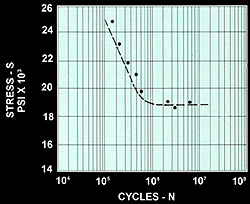
Fatigue Crack Initiation Testing
Perhaps the most familiar type of fatigue test would be classified as a “crack initiation” process. With this method, specimens of a material (or the actual parts) are subjected to repeated stress cycles until a crack is initiated . . .or is allowed to continue to grow until total fracture occurs. Stress cycles can be applied axially, in plane bending, in rotating bending, in torsion, or in combination. These test modes utilize cycles of minimum to maximum tensile stress, or reversed cycles of tensile and compressive stress. The resultant of the minimum stress divided by the maximum stress is termed the “stress ratio.”

logarithmic scale
Typically, a logarithmic scale is used for the horizontal axis while the vertical axis uses a linear scale. Specimens are tested in a series of decreasing stress levels until no failure occurs within a selected maximum number of cycles (usually 10 million cycles). The nearly horizontal portion of the curve defines the fatigue or endurance limit for the test material. For many nonferrous materials, however, there will not be a definite endurance limit and the low stress portion of the curve will not have a horizontal slope.
HOW IS A FATIGUE TEST CONDUCTED?
Each test specimen is cycled over a constant load (stress) or displacement (strain) range until a crack or total fracture occurs. The number of test cycles required to produce the desired failure yields a single data point. Multiple specimens are tested at selected stress levels and the number of cycles to failure of each is plotted against the applied stress amplitude.
HOW COULD WE USE THE TEST INFORMATION?
Fatigue data can be used for a number of purposes including:
-
Various manufacturing processes
-
Different material compositions
-
Variances in material lots
-
Effects of surface finish, heat treating, shot peening and other geometric factors
-
Effects of corrosive or high temperature environments
-
Optimizing designs
WHAT ARE SOME APPLICATIONS?
Specific examples of applying fatigue test results cover a wide variety of situations:
-
Quality control of piston forgings
-
Effects of laser etching prosthetic devices
-
Integrity of welding processes
-
Evaluating powdered metal materials
-
Durability of electronic circuit connections
-
Compressor valve life expectancy
-
Selection of spur gear alloys
-
Fastener capability comparisons
-
Engine valve treatment analysis
-
Wave spring washer reliability
-
Suspension bridge cable life expectancy
-
Trailer body durability
-
Piston ring quality
-
Effects of plastic bead shot peening
-
Evaluation of casting processes
-
Steel chain quality control

